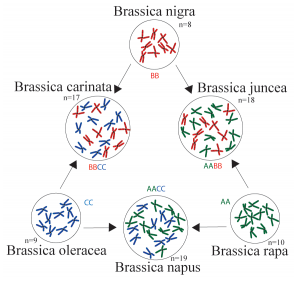 The Triangle of U demonstrates the evolution and relationships between members of the plant genus Brassica, showing how genomes of three ancestral species of Brassica combined to create three of the common contemporary vegetables and oilseed crop species. It was named after Nagaharu U, a Korean botanist who published the theory in 1935 as part of his studies on Brassica species.
The Triangle of U demonstrates the evolution and relationships between members of the plant genus Brassica, showing how genomes of three ancestral species of Brassica combined to create three of the common contemporary vegetables and oilseed crop species. It was named after Nagaharu U, a Korean botanist who published the theory in 1935 as part of his studies on Brassica species.
The Triangle of U diagram shows the genetic relationship between the six species of the genus Brassica. Three of the Brassica species were derived from three ancestral genomes, denoted by the letters AA (rapa), BB (nigra) or CC (oleracea). Alone each of these diploid genomes produced a common Brassica species.
The Letter n denotes the number of chromosomes in each genome. For example, Brassica rapa an A – n=10 designation . That means each stomatic cell of the plant contains two complete genome copies (diploid) and each genome has ten chromosomes. Each cell will contain 20 chromosomes. Brassica rapa, Brassica oleracea and Brasica napus are separate species , but it was possible for them to interbreed because they are closely related. This interspecific breeding led to the creation of three new species of tetraploid Brassica – AABB (Brassica juncea, AACC (Brassica napus) and BBCC (Brassica Carinata)
Modern examples within the Triangle of U
Sprout (Brassica oleracea)
Variety: The Flower Sprout TM
Breeder: Tozer Seeds
Kale (Brassica oleracea)
Variety: TZB 9334
Breeder: Tozer Seeds
Swede (Brassica napus)
Variety: TweedF1
Breeder: Elsoms Seeds Ltd
Khol Rabi (Brassica oleracea)
Variety: Kossak F1 & Kohibri F1
Breeder: Elsoms Seeds Ltd
Broccoli (Brassica oleracea)
Variety: Beneforte
Breeder: Seminis Vegetable Seeds
Cabbage (Brassica oleracea)
Variety: Lodero F1 & Deadon F1
Breeder: Elsoms Seeds Ltd
Spring rape (Brassica napus)
Variety: Tamarin
Breeder: Senova
Black mustard (Brassica nigra)
Ethiopian mustard (Brassica carinata)
Indian mustard (Brassica juncea)
Turnip (Brassica rapa)
Turnip rape (Brassica rapa)
Pak choi ( Brassica rapa)


